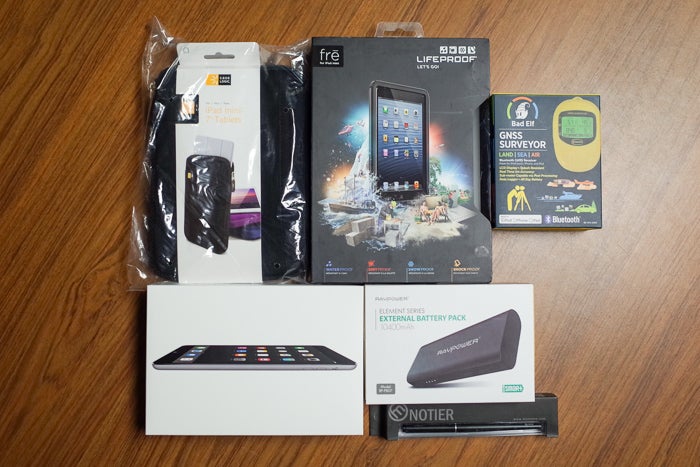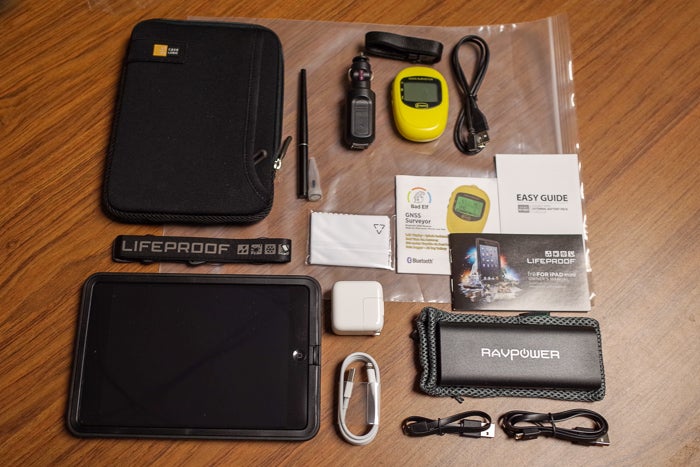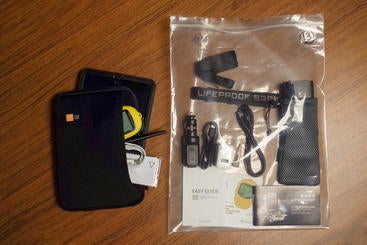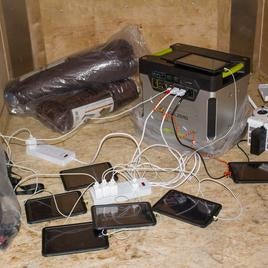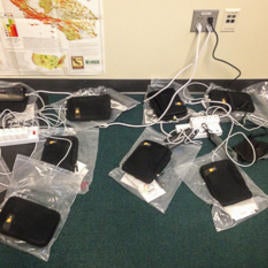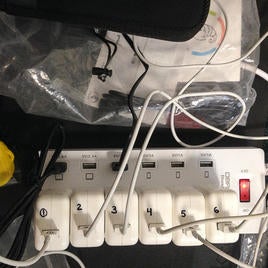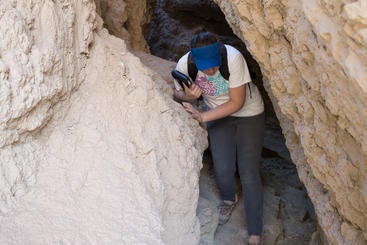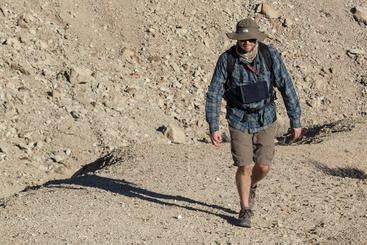We adapt the term "GeoPad" used by Science Education Research Center (SERC) to describe our iPad tablet-based field mapping system capable of integrated GPS/GIS/measurement/photo/data collection in a rugged field-ready format that can be held in one hand. This system is appropriate for field geology applications across teaching, research, and industry. Much of the technology and methods are also appropriate for other field-based disciplines such as environmental sciences and archaeology.
Trials & Tribulations
About a dozen tablet devices and several software suites were trialed (listed below) before we invested in a full class set of twenty tablets for student use. The trial process consisted of (1) self-trialing several different systems in the course of research fieldwork, and (2) selecting three undergraduates to trial the two most promising systems (iPad Mini 2, Microsoft Surface Pro 4) in the course of senior thesis projects.
Usability, functionality, robustness, and price were all key considerations. Each device and software combination has advantages and disadvantages that are beyond the scope of discussion here. Going into the project it was my hope was that a Windows-based product would give the greatest flexibility in and out of the field, but no such device currently exists that has reliable internal sensors capable of accurate structural measurements. In the Resources section you will find references to several software suites (both homegrown and third party) being utilized in field studies. If field collection of point-centric metadata is your primary concern, one of these other software suites may be better suited. For importing basemaps, point/line/polygon mapping of geologic features, measurements, annotated photos, and in-field stereonet visualization, I have found FieldMove to be the most powerful and intuitive software available. In the course of testing, an iPad Mini 2 in a ruggedized Lifeproof case running FieldMove emerged as the best compromise of available technology.
|
List of Devices Trialed |
(Partial) List of Software Trialed |
|---|---|
|
Getac Z710 (Android) |
ArcGIS 10 (Windows) |
Tipping the Scales
I will generalize that for the last 10+ years digital geologic field mapping has largely been treated as an expensive novelty with considerable promise that had difficulty delivering. With fast-moving technologies (tablets, GPS, UAVs, etc.) and the advent of new softwares, the last couple years have seen a dramatic shift that I'd argue have tipped the scales towards a digital field workflow.
Some of the key advantages and disadvantages of our GeoPad system are highlighted below. These can also be generalized as the current advantages and disadvantages of digital field mapping. I emphasize that both students and I agree that the advantages to this system outweigh the advantages of traditional paper-based mapping in most circumstances, both in research and teaching applications.
UCR GeoPad System Components
Click the pluses to expand the component's description. We issue one kit per student. Cost per kit starts at $350 each.
The Kit
-
iPad Mini 2 Cellular 16-64GB $250-450
-
We chose the iPad Mini platform (over generally more versatile Windows and Android based systems, including field-ready rugged tablets) because no other device tested had as reliable internal sensors (GPS, clinometer, compass, camera). Screen quality (sensitivity/brightness/resolution), size, battery life, ability to be ruggedized, and cost were also critical considerations that generally ruled in the iPad Mini's favor.
-
Avoid the iPad Mini 4 for the moment! We use the iPad Mini 2 which is still sold by Apple and is also available via online retailers. The iPad Mini 4 (newest version) has several technical improvements over the Mini 2 (8 vs. 5 MP camera, fingerprint sensor, anti-reflective screen, 1.3x faster CPU, 1.6x faster graphics) but a fatal flaw in that Apple designed the Mini 4 to be 3mm longer, which makes it incompatible with all completely enclosed cases on the market. I have not found a marked speed or stability advantage of the Mini 4 over the Mini 2. The Mini 2 starts at $150 cheaper and accessories are available online at closeout prices. A further caution that the screenless Lifeproof NUUD iPad Mini 4 case has frivolous metal components that deflect the internal compass up to 40 degrees and render internal measurements unusable!
-
I strongly recommend the "Cellular" version (specific carrier does not matter) as the "WIFI-only" versions do not have a GPS chip! The internal GPS on the cellular version can readily be used without phone contracts to obtain +/-10m positional accuracy. This is an A-GPS chip which relies partly on cell towers to locate you; in wooded or very remote areas it can take many minutes to get an initial satellite fix.
-
I suggest obtaining the largest internal memory possible (32GB for the iPad Mini 2) to allow plenty of large map layer files to be loaded and ensure room for apps and photos.
-
-
Lifeproof iPad Mini 2 Case $30-60
-
These dustproof, waterproof, somewhat drop-proof cases allow full functionality of the touchscreen and all sensors. The all-plastic design ensures that the internal compass provides accurate measurements. The slim profile makes for easy handling. The iPad is charged via a flip port at the bottom. Once properly installed, there is no need to ever remove the case which keeps the iPad in pristine condition. If the case is dusty the easiest way to clean it is to run the whole case under a faucet. A neck strap (included) is a nice option many students preferred.
-
These cases (originally retailing at $100) can currently be found an excellent prices through online retailers. The cases built for iPad Mini 1 or Mini 2 are preferable as the iPad Mini 3 cases feature a weak spot over the home button to allow fingerprints to be scanned (I have already seen a screen shattered from rock chips hitting this improbable bull's eye). Buy extra if you can as they will likely become hard to find as Apple moves on to other products. They are "lifeproof" maybe, but not necessarily student-proof. The case's screen will become scratched but protect the tablet inside. Cases built for iPad Mini 4 are incompatible!
-
-
External Battery $25
- For the price an external battery pack is well worth the investment to be sure your tablet does not run out of battery at some critical moment while in the field. There are many robust and reliable options available on the market (we trialed several). Assuming you have access to electricity in the evenings, a good option is the RAVPower 13400mAh 3.5A portable charger bank ($25), which has a slim design and is capable of fully charging an iPad Mini once before needing to recharge.
-
Neoprene Case $10
-
I tried about a half dozen exterior cases and found the "CaseLogic iPad mini 7" tablet" case to be the best. No sleeve-style case that I have found is designed to house an iPad Mini in a Lifeproof case (which adds thickness in all dimensions) but this neoprene case will stretch to barely allow it. The handy zippered front pocket is ideal for storing GPS, stylus and other key accessories. The size and texture makes it very convenient to hold in a hand while walking across the field area. This particular case has stood up well to field abuse.
-
This system actually has three layers of protection! The Lifeproof case (which should always be used), the neoprene case (which should always protect the iPad except when it is directly being used), and a large, sturdy plastic zip-lock bag (sized to contain the entire kit and protect from dust and rocks in backpacks).
-
-
Stylus $15
-
Although a stubby finger works just fine for most applications, a stylus allows for near-pencil precision of linework and thus should be considered an important component of the kit. We like the Musemee Notier V2, which has a smart screw-on design that protects the delicate tip when not in use (and comes with a spare tip). The tip consists of a clear plastic conductive disc which precisely averages the screen's capacitive response to the pencil-thick center.
-
These tips do break from misuse and abuse so it is wise to emphasize proper use to students and purchase extra tips ahead of time.
-
-
Software $30-80
-
FieldMove by Midland Valley ($30) is the critical "app" that makes the system work. A wide range of apps (both free and paid) are worth investing in to greatly expand the functionality of the GeoPads (word processing, pdf viewing, cloud sharing, wifi printing, geology reference, etc.). A full list of suggested apps and their function is detailed in the software section.
-
Bonus! If all the iPad are linked to the same Apple account (detailed in the setup section), the software is a one-time expense (rather than per kit).
-
-
Bad Elf GPS (optional) $150-600
-
If you purchased the cellular iPad and 10m GPS positional accuracy is good enough (true of most undergraduate-level mapping projects as we found out), then you do not need to purchase this item. For greater accuracy Bad Elfs (elves?) are user-friendly stand-alone GPSs that can wirelessly connect to an iPad via bluetooth and override the iPad's internally derived location. Essentially this can enable an iPad to give positionally accurate locations down to 1m accuracy without compromising the integrity of the iPad case. The Bad Elf has all-day battery life with its rechargeable internal battery.
-
The Bad Elf Pro+ ($300 retail) is capable of 2.5m positional accuracy. The Bad Elf GNSS Surveyor ($600) is capable of out-of-the box 1.0m positional accuracy, and claims capability of 10-50cm accuracy with data post-processing ("coming soon" they say; watch out Trimble if they figure it out). For research-grade field mapping I have found the GNSS version to be a worthwhile investment.
-
Bonus! A single Bad Elf GPS can connect to five bluetooth devices at a time in an 30ft radius, meaning if you have students working in groups they may only need one device per group.
-
Group Gear
-
Power strips
- Good quality power strips with surge protection capable of charging 6 outlet and 6 USB devices at the same time go for about $27. Buy as many as needed.
-
Storage container
- I use Rubbermaid ActionPackers (rugged plastic bins) to store and transport the tablets. They can also be locked with luggage locks for peace of mind.
-
Laptop computer (optional)
- While an instructor's laptop is perfectly suitable to interface with the GeoPads (setup/import/export), it may be preferable to have a dedicated laptop for this job. Anything with a USB port and Apple's iTUnes software will do. I use a Microsoft Surface laptop/tablet hybrid that also has ArcGIS loaded.
-
Solar generator system (optional)
- If your field camp does not have electricity, a solar generator kit may be an option. The Goal Zero Yeti kit (~$2000) includes solar panels and generator and has energy storage for about 45 tablet charges. We have successfully charged over 15 tablets and UAV batteries overnight using only 20% of the Yeti's storage capacity.
(click to see larger)

